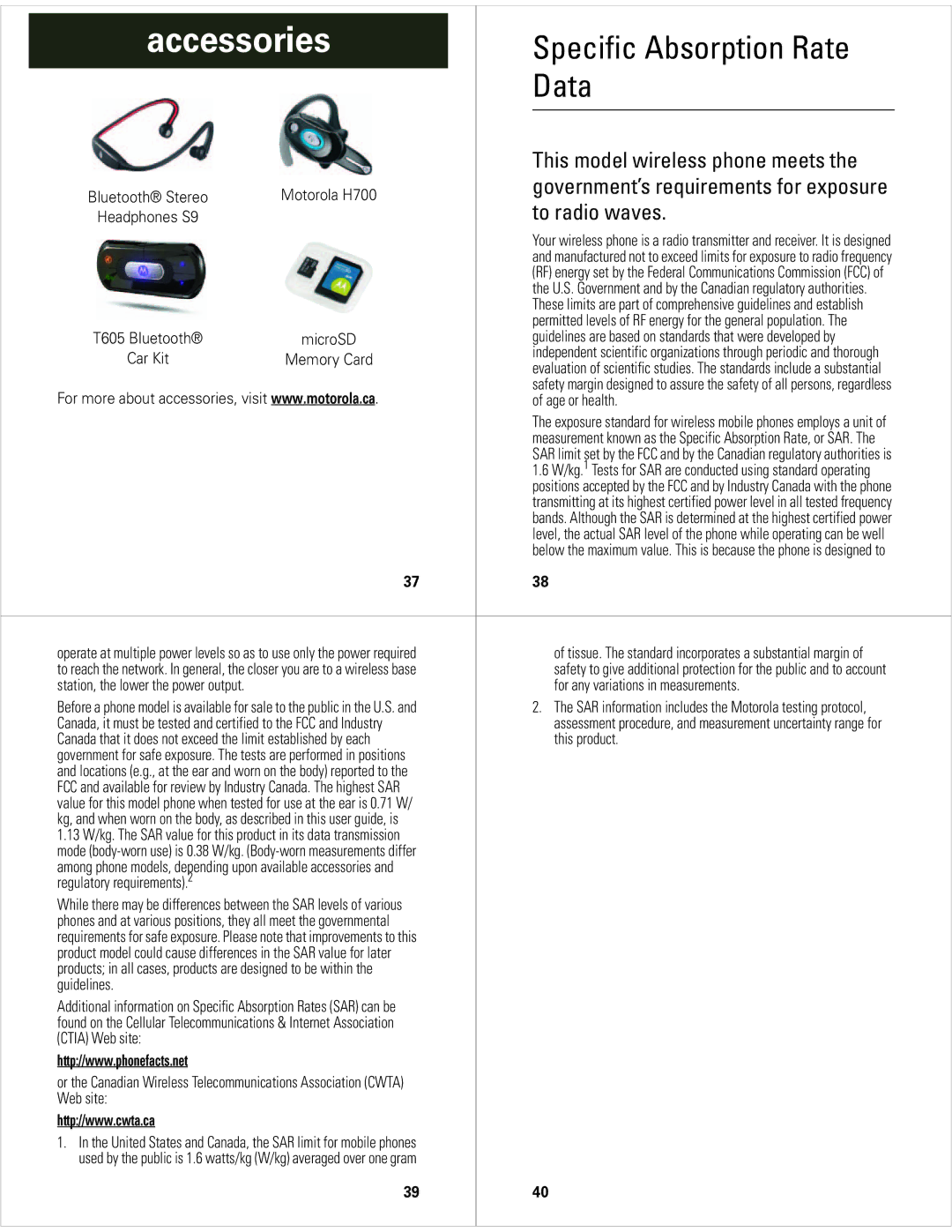
| accessories |
| Specific Absorption Rate |
| |
| accessories |
|
| Data |
|
|
|
|
|
|
|
|
|
|
| This model wireless phone meets the |
|
| Bluetooth® Stereo | Motorola H700 |
| government’s requirements for exposure |
|
|
| to radio waves. |
| ||
| Headphones S9 |
|
|
| |
|
|
|
| Your wireless phone is a radio transmitter and receiver. It is designed |
|
|
|
|
| and manufactured not to exceed limits for exposure to radio frequency |
|
|
|
|
| (RF) energy set by the Federal Communications Commission (FCC) of |
|
|
|
|
| the U.S. Government and by the Canadian regulatory authorities. |
|
|
|
|
| These limits are part of comprehensive guidelines and establish |
|
|
|
|
| permitted levels of RF energy for the general population. The |
|
| T605 Bluetooth® | microSD |
| guidelines are based on standards that were developed by |
|
| Car Kit | Memory Card |
| independent scientific organizations through periodic and thorough |
|
|
| evaluation of scientific studies. The standards include a substantial |
| ||
|
|
|
|
| |
| For more about accessories, visit www.motorola.ca. |
| safety margin designed to assure the safety of all persons, regardless |
| |
|
| of age or health. |
| ||
|
|
|
| The exposure standard for wireless mobile phones employs a unit of |
|
|
|
|
| measurement known as the Specific Absorption Rate, or SAR. The |
|
|
|
|
| SAR limit set by the FCC and by the Canadian regulatory authorities is |
|
|
|
|
| 1.6 W/kg.1 Tests for SAR are conducted using standard operating |
|
|
|
|
| positions accepted by the FCC and by Industry Canada with the phone |
|
|
|
|
| transmitting at its highest certified power level in all tested frequency |
|
|
|
|
| bands. Although the SAR is determined at the highest certified power |
|
|
|
|
| level, the actual SAR level of the phone while operating can be well |
|
|
|
|
| below the maximum value. This is because the phone is designed to |
|
|
| 37 | 38 |
| |
|
|
|
|
| |
| operate at multiple power levels so as to use only the power required |
| of tissue. The standard incorporates a substantial margin of |
| |
| to reach the network. In general, the closer you are to a wireless base |
| safety to give additional protection for the public and to account |
| |
| station, the lower the power output. |
|
| for any variations in measurements. |
|
| Before a phone model is available for sale to the public in the U.S. and |
| 2. The SAR information includes the Motorola testing protocol, |
| |
| Canada, it must be tested and certified to the FCC and Industry |
| assessment procedure, and measurement uncertainty range for |
| |
| Canada that it does not exceed the limit established by each |
| this product. |
| |
| government for safe exposure. The tests are performed in positions |
|
|
| |
| and locations (e.g., at the ear and worn on the body) reported to the |
|
|
| |
| FCC and available for review by Industry Canada. The highest SAR |
|
|
| |
| value for this model phone when tested for use at the ear is 0.71 W/ |
|
|
| |
| kg, and when worn on the body, as described in this user guide, is |
|
|
| |
1.13W/kg. The SAR value for this product in its data transmission mode
among phone models, depending upon available accessories and regulatory requirements).2
While there may be differences between the SAR levels of various phones and at various positions, they all meet the governmental requirements for safe exposure. Please note that improvements to this product model could cause differences in the SAR value for later products; in all cases, products are designed to be within the guidelines.
Additional information on Specific Absorption Rates (SAR) can be found on the Cellular Telecommunications & Internet Association (CTIA) Web site:
http://www.phonefacts.net
or the Canadian Wireless Telecommunications Association (CWTA) Web site:
http://www.cwta.ca
1.In the United States and Canada, the SAR limit for mobile phones used by the public is 1.6 watts/kg (W/kg) averaged over one gram
39 | 40 |
